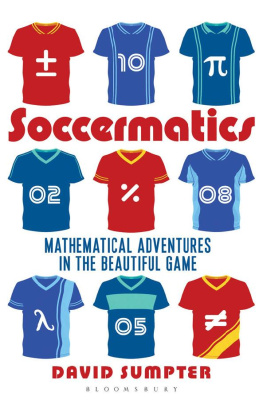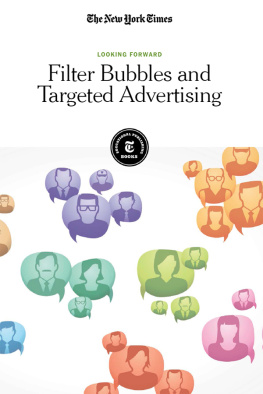
Also available in the Bloomsbury Sigma series:
Sex on Earth by Jules Howard
p53: The Gene that Cracked the Cancer Code by Sue Armstrong
Atoms Under the Floorboards by Chris Woodford
Spirals in Time by Helen Scales
Chilled by Tom Jackson
A is for Arsenic by Kathryn Harkup
Breaking the Chains of Gravity by Amy Shira Teitel
Suspicious Minds by Rob Brotherton
Herding Hemingways Cats by Kat Arney
Electronic Dreams by Tom Lean
Sorting the Beef from the Bull by Richard Evershed and Nicola Temple
Death on Earth by Jules Howard
The Tyrannosaur Chronicles by David Hone
Soccermatics by David Sumpter
Big Data by Timandra Harkness
Goldilocks and the Water Bears by Louisa Preston
Science and the City by Laurie Winkless
Bring Back the King by Helen Pilcher
Furry Logic by Matin Durrani and Liz Kalaugher
Built on Bones by Brenna Hassett
My European Family by Karin Bojs
4th Rock from the Sun by Nicky Jenner
Patient H69 by Vanessa Potter
Catching Breath by Kathryn Lougheed
PIG/PORK by Pa Spry-Marqus
The Planet Factory by Elizabeth Tasker
Wonders Beyond Numbers by Johnny Ball
Immune by Catherine Carver
I, Mammal by Liam Drew
Reinventing the Wheel by Bronwen and Francis Percival
Making the Monster by Kathryn Harkup
Best Before by Nicola Temple
Catching Stardust by Natalie Starkey
Seeds of Science by Mark Lynas

Contents
Thank you to all the people who I interviewed or answered my questions over email for this book. These include, but are not limited to, Adam Calhoun, Alex Kogan, Amit Datta, Angela Grammatas, Anupam Datta, Bill Dieterich, Bob Huckfeldt, Brian Connelly, CCTV Simon, David Silver, Emilio Ferrara, Garry Gellade, Glenn McDonald, Harm van Seijen, Hunt Allcott, Joanna Bryson, Johan Ydring, Julia Dressel, Katie Genter, Kathleen Richardson, Kristina Lerman, Marc Keuschnigg, Matthew Gentzkow, Michael Wood, Michela Del Vicario, Mona Chalabi, Olle Hggstrm, Oriol Vinyals, Santo Fortunato, Tassos Noulas, Tim Brennan, Tim Laue and Tomas Mikolov. I learnt so much from all of you. Thank you very much.
I want to say a special thanks to both Renaud Lambiotte and Michal Kosinski for long conversations I had with both of you as I started this book. You provided me with a proper rational framework for reasoning about the dangers, real and imaginary, of algorithms. This book would have been not nearly as good without that input.
Thanks to Mum and Dad for reading the book so thoroughly and for all the comments. Even now I am properly grown up, I still feel you support me so much.
At Bloomsbury, I would like to thank Rebecca Thorne for the trip to Google that started this book; Anna MacDiarmid for all her input and encouragement and Jim Martin for his faith in me. Im not sure how we can turn this book into an excuse to see the Pars together, but Ill try to think of something.
Thank you to Emily Kearns for careful copyediting and numerous improvements made to the text.
A special thanks to Alex Szorkovszky for his work on the Tolstoy generator, measuring the accuracy of election predictions and dissection of Tinder. Thanks also for putting up with my long uncontrollable rants about the pros and cons of algorithms. This last piece of thanks should also be extended to my research group in Uppsala. Thank you, in particular, to my PhD students (Ernest, Bjrn and Linnea) who have been so patient with me during the writing of this book.
Thank you to Anna Baddeley for commissioning and giving feedback on Outnumbered articles for Economist 1843 . I learnt a lot from you about the level and balance required when writing about maths.
Thank you to Joakim Johannson for doing his masters project on Twitter and helping me understand echo chambers on the platform.
The idea for Outnumbered evolved from a conversation (the day after I visited Google) with my agent Chris Wellbelove about writing a book called Maths is Evil . Maths didnt turn out to be quite as evil as we maybe saw it that day but, as ever, I am grateful for the clear way of thinking you provide. I have learnt so much from you.
The title itself is due to my wife Lovisa, who told it to me reflexively when I told her what I wanted to write. Thank you for this and so much more. I enjoy every day of my life with you.
This book would not have been possible without the help of my children, Elise and Henry. Clearly, you both understand everything to do with our life online a lot better than I do, so thanks for patiently explaining it to me. And for being the best kids ever.
In March 2016, three researchers from London and a criminologist from Texas published a paper in the Journal of Spatial Science . The methods presented were dry and scholarly, but the article was not an abstract academic exercise. The title made the aim clear: Tagging Banksy: using geographic profiling to investigate a modern art mystery. Mathematics was being used to track down the worlds most famous graffiti artist.
The researchers used Banksys website to identify the location of his street art. They then systematically visited each of his works, both in London and his home town of Bristol, with a GPS recorder. Data collected, they created a heat map in which warmer areas showed where Banksy was more likely to have lived, assuming that he created his work near to his home.
The hottest point on the London geo-profile map was only 500m from the former address of the girlfriend of one person who had previously been suggested to be Banksy. On the Bristol map, the colour was hottest around the house this same person lived at and the football pitch of the team he played for. The geo-profiled person, the article concluded, was very likely to be Banksy.
Upon reading the article, my first reaction was the mixture of interest and jealousy that most academics feel when their colleagues do something smart. This was a clever choice of application. Exactly the type of applied maths I aspire to do: well executed with a twist that captures the imagination. I wished Id done it myself.
But as I read on, I started to feel slightly annoyed. I like Banksy. I have that book of his pictures and flippant quotes on my coffee table. I have wandered around the backstreets of cities looking for his murals. I have laughed at the video where his valuable artwork fails to sell from a stall he set up in Central Park in New York City. His creations in the West Bank and the migrant camps in Calais have provided me with an uncomfortable reminder of my own privileged position. I dont want some emotionally disconnected academics using their algorithm to tell me who Banksy is. The whole point of Banksy is that he sneaks unnoticed through the night and in the morning light his art reveals the hypocrisies of our society.
Mathematics is destroying art: cold logical statistics chasing hoody-wearing freedom fighters around the backstreets of London. It is just not right. It is the police and tabloid newspapers that should be looking for Banksy, not liberal-minded academics. Who do these smart-arses think they are?
I read the Banksy article a few weeks before my own book, Soccermatics , was due to be published. My aim in writing a football book had been to take readers on a mathematical journey into the beautiful game. I wanted to show that the structure and patterns underlying football were full of mathematics.










